In 1832, William Winsor, a chemist, and Henry Newton, an artist, entered into partnership as artists' colourmen. With a business founded on the marriage of art and science, the pair set out to respond to the needs of artists and offer them the widest choice of colours with the greatest permanence.
This combination of scientific rigour and a new spirit of enquiry into the craft of the artists' colourmen enabled Winsor and Newton to set new standards for colour permanence and clarity and within a few short years, Winsor & Newton had become the largest artists' materials supplier in the world.
1932-1850
Winsor and Newton founded their business in 1832 at a time of extreme social and cultural change in Britain. The Industrial Revolution was fully fledged and was therefore generating an explosion of technology and trade from all over the world, enabling new materials to be brought into England.
With their aim of providing the best choice of pigments with the highest permanence possible, Winsor and Newton were able to take full advantage of the opportunities that were opening up to them and within a couple of decades had introduced many new pigments and colour ranges.
| 1832 |
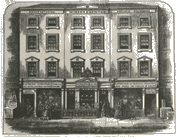 Winsor & Newton is founded at 38 Rathbone Place, London Winsor & Newton is founded at 38 Rathbone Place, London
William Winsor and Henry Newton established their partnership at 38 Rathbone Place, London. This was Henry's home, which was then part of an artists' quarter in which a number of eminent painters, including Constable, had studios, and where other colourmen were already established.
|
| 1835 |
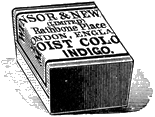 The world's first moist water colours are launched The world's first moist water colours are launched
In 1835, Winsor and Newton developed the first moist water colours utilising the moisture-retaining properties of a recently discovered material, glycerine.
The new water colour pans were much simpler and more convenient to use than water colour cakes and quickly earned well-deserved popularity. Artists such as Turner were now able to paint outdoors prolifically in water colour.
|
| 1835 |
The earliest negative photograph is taken by William Henry Fox Talbot.
|
| 1837 |
Queen Victoria ascends the throne. |
| 1841 |
 Royal Warrant issued by Queen Victoria & Prince Albert Royal Warrant issued by Queen Victoria & Prince Albert
Royal recognition came early for Winsor and Newton in the form of appointment as artists' colourmen to Queen Victoria in 1841 and the issuing of the Royal Warrant.
|
| 1842 |
 The collapsible, screw cap tube mechanism is patented The collapsible, screw cap tube mechanism is patented
William Winsor patented the first screw cap mechanism for a collapsible metal tube. Following this invention, tin tubes were very quickly accepted as containers for oil colours and a few years later Winsor and Newton were able to uniquely offer moist water colours in tubes.
|
| 1844 |
JMW Turner exhibits "Rain, Steam & Speed - The Great Western Railway". Increased transportation combined with the availability of paints in metal tubes enabled artists to travel and paint outdoors like never before. |
| 1848 |
Pre-Raphaelite Brotherhood is started by DG Rossetti, Millais & Holman-Hunt. |
1851 - 1900
High-quality products together with the prestige of royal appointments and awards at international exhibitions helped to stimulate trade for Winsor and Newton overseas. During the second half of the nineteenth century there was hardly any competition in the manufacture of artists' materials in non-European countries and this doubtless encouraged ever-increasing exports to the U.S.A. and also India and Australia.
During 1890, William Killik, son in law to Mr. Thrupp, an original director with William and Henry, travelled to New York on the Majestic, the predecessor to the Titanic. Whilst on deck an American asked him his business and Killik replied "artists' materials". "Oh", he said "if you're going to sell artists' colours, you may as well take the next boat back because there is nothing sold in the United States but Winsor & Newton!"
| 1851 |
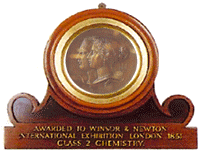 Crystal Palace Great Exhibition Crystal Palace Great Exhibition
Winsor and Newton exhibited at The Great Exhibition of 1851 in the Crystal Palace and were awarded the only prize medal open to competitors for artists' colours. This was the first of many successful exhibits in numerous International Exhibitions, including the Chicago World Exhibition in 1893, where Winsor and Newton were awarded the medallion for the development of permanent artists' colours.
|
| 1859 |
Charles Darwin publishes "The Origin of the Species" establishing evolution by common decent.
|
| 1874 |
Claude Monet exhibits "Impression: Sunrise" at the first exhibition of the French Impressionists. This exhibition marks the birth of Impressionism. |
| 1876 |
Alexander Graham Bell patents the telephone.
|
| 1881 |
 Winsor & Newton Limited Company is formed Winsor & Newton Limited Company is formed
A few months before the death of Henry Newton in 1882, Newton sold the business to the newly incorporated firm of Winsor & Newton Ltd which included members of both families amongst the shareholders, with Newtons employed until the late 1970's.
|
| 1888 |
Vincent Van Gogh paints four "Sunflower" paintings between August - September in Arles, France.
|
| 1892 |
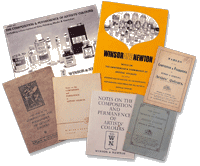 The Composition & Permanence of Artists' Colours first published The Composition & Permanence of Artists' Colours first published
Wholly dedicated to ensuring artists used the most stable and permanent pigments, Winsor & Newton were the first artists' colourmen to publish the composition and permanence of their colours.
|
1901 - 1950
Until the beginning of the twentieth century Winsor & Newton had concentrated entirely on products for painting and drawing. However, by the Edwardian period the painting market was very different due to the invention of the camera and artists were no longer in such great demand.
The company began to take up craft products, starting with pen painting materials in 1911, and the range was expanded over the following years.
It was fortunate that home trade was broadened in such a way, for overseas trade suffered a series of setbacks during the first world war years and subsequent depression. However, during the second world war manufacture of artists' and draughtsmen's materials continued for the war effort despite limitations imposed by raw materials shortages.
| 1907 |
Picasso paints "Les Demoiselles d'Avignon" which is exhibited at the first Cubist exhibition in Paris in the same year. |
|
1914-
1918
|
World War One
This cataclysmic event ends the main era of the British Empire forever.
|
| 1937 |
 Winsor & Newton develop student quality products & launch Designers' Gouache Winsor & Newton develop student quality products & launch Designers' Gouache
By the 1930's the conditions of economic depression had had a very serious effect on the volume of trade both at home and overseas, and directors of the firm decided to compensate for this by making and selling colours of students' quality. Innovation continued throughout the decade, however, and in 1937, Designers Gouache was introduced, a highly pigmented opaque water colour. It became the most popular medium used by graphic designers and also allowed fine artists to use body colour in water colour without having to add white to ordinary water colour.
|
| 1937 |
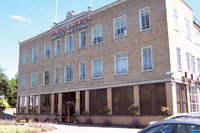 Colour Works open at present day Harrow Site Colour Works open at present day Harrow Site
To increase efficiency and reduce costs, all Winsor & Newton activities were moved to Wealdstone, Harrow. Colour manufacture was transferred there from the North London Colour Works in 1938 and the administrative offices were moved from Rathbone Place the following year. This was good fortune indeed as it meant our archives and business were safe when Rathbone Place was destroyed in the London blitz just a year later.
|
|
1939-
1945
|
World War Two
The Cold War followed the enormity of this war which continued to dominate world relationships for subsequent decades.
|
| 1946 |
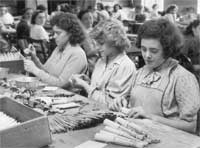 Brush making facility opens in Lowestoft Brush making facility opens in Lowestoft
In the immediate post-war years after the activity of war, brush-makers tended not to return to a sedentary occupation. For this reason it was necessary to look for a new factory site in an area with a surplus of labour. The East Anglian fishing port of Lowestoft proved perfect, as the skills required for mending the fishing nets could be transferred to tying knots for brushes. A brush making department also continued at Harrow until 1982.
|
| 1948 |
Jackson Pollock paints "No. 1", a giant example of abstract expressionism created by "flung" paint |
1951 - 2007
| 1963 |
The first large scale exhibition of Pop Art takes place in the New York Guggenheim museum, bringing Pop Art to a broader international audience. |
| 1969 |
Neil Armstrong becomes the first man on the moon.
|
| 1971 |
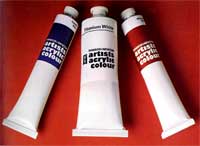 Launch of Winsor & Newton Artists' Acrylic Range Launch of Winsor & Newton Artists' Acrylic Range
In 1970, Winsor & Newton introduced their first range of Artists' Acrylics, a revolutionary water based paint, which has subsequently become as popular as oil colour.
|
| 1976 |
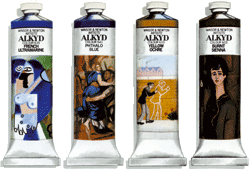 The world's first artists' alkyd range is launched The world's first artists' alkyd range is launched
In 1976 the first alkyd colour for artists was introduced by the company. This fast drying oil colour range enabled outdoor artists and designers to complete oil paintings in a fraction of the time required with conventional oils.
|
| 1990 |
The World Wide Web/Internet protocol is created by Tim Berners-Lee. |
| 1996 |
 Artists' Water Colour re-launch Artists' Water Colour re-launch
In 1996, Winsor & Newton embarked on the most significant change to the Artists' Water Colour range in 164 years. The availability of so many new pigments meant that 35 new colours were introduced into the range, offering artists the widest and most balanced spectrum with the greatest permanence.
|
1996-
1999 |
The importance and influence of the Young British Artists movement was verified at the "Sensation" show which attracted mass media and public attention in London and New York. |
| 1998 |
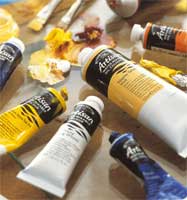 Winsor & Newton launch Artisan Water Mixable Oil Colour Winsor & Newton launch Artisan Water Mixable Oil Colour
Winsor & Newton revealed the results of a long research project to supply a range of both colours and mediums in oil which could be thinned and cleaned up with water. This range has allowed an enormous number of artists to enjoy oil colour without the use of hazardous solvents.
|
| 2000 |
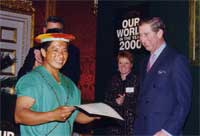 Winsor & Newton run the world's largest painting competition to celebrate the Millennium Winsor & Newton run the world's largest painting competition to celebrate the Millennium
Winsor & Newton launched a worldwide painting competition, "Our World in the Year 2000", to celebrate the Millennium year. The largest art event of its kind ever held, the competition attracted entries from over 22,000 artists in 51 different countries, with judging chaired by H.R.H The Prince of Wales.
|
| 2007 |
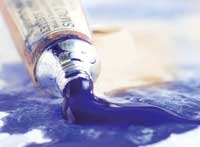 Winsor & Newton celebrate 175th Anniversary and develop Smalt Winsor & Newton celebrate 175th Anniversary and develop Smalt
In 2007 Winsor & Newton celebrate 175 years of colour making. To commemorate this milestone event, we have re-formulated Smalt, a beautiful blue pigment that was used in ancient times but subsequently became obsolete.
Today, in our 175th year, we are proud to have been able to re-formulate this colour to match our best quality sample from the nineteenth century, offering artists a beautiful, deep blue water colour that has a large particle structure, resulting in washes that really sparkle and suggest beautiful texture!
|
Back to top











 Winsor & Newton is founded at 38 Rathbone Place, London
Winsor & Newton is founded at 38 Rathbone Place, London
 Royal Warrant issued by Queen Victoria & Prince Albert
Royal Warrant issued by Queen Victoria & Prince Albert The collapsible, screw cap tube mechanism is patented
The collapsible, screw cap tube mechanism is patented Crystal Palace Great Exhibition
Crystal Palace Great Exhibition Winsor & Newton Limited Company is formed
Winsor & Newton Limited Company is formed The Composition & Permanence of Artists' Colours first published
The Composition & Permanence of Artists' Colours first published Winsor & Newton develop student quality products & launch Designers' Gouache
Winsor & Newton develop student quality products & launch Designers' Gouache Colour Works open at present day Harrow Site
Colour Works open at present day Harrow Site Brush making facility opens in Lowestoft
Brush making facility opens in Lowestoft Launch of Winsor & Newton Artists' Acrylic Range
Launch of Winsor & Newton Artists' Acrylic Range  The world's first artists' alkyd range is launched
The world's first artists' alkyd range is launched  Artists' Water Colour re-launch
Artists' Water Colour re-launch Winsor & Newton launch Artisan Water Mixable Oil Colour
Winsor & Newton launch Artisan Water Mixable Oil Colour Winsor & Newton run the world's largest painting competition to celebrate the Millennium
Winsor & Newton run the world's largest painting competition to celebrate the Millennium Winsor & Newton celebrate 175th Anniversary and develop Smalt
Winsor & Newton celebrate 175th Anniversary and develop Smalt